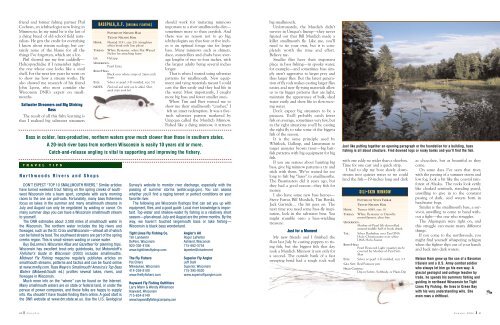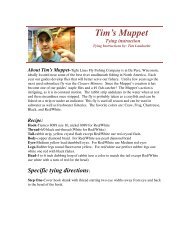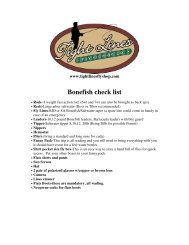30-41 Achigan - Tight Lines Fly Fishing Co.
30-41 Achigan - Tight Lines Fly Fishing Co.
30-41 Achigan - Tight Lines Fly Fishing Co.
You also want an ePaper? Increase the reach of your titles
YUMPU automatically turns print PDFs into web optimized ePapers that Google loves.
<strong>30</strong>-<strong>41</strong> <strong>Achigan</strong> 6/19/06 7:32 PM Page 40<br />
friend and former fishing partner Phil<br />
<strong>Co</strong>chran, an ichthyologist now living in<br />
Minnesota. In my mind he is the last of<br />
a dying breed of old-school field naturalists.<br />
He gets the credit for everything<br />
I know about stream ecology, but certainly<br />
none of the blame for all the<br />
things I’ve forgotten, which are a lot.<br />
Phil showed me my first caddisfly—<br />
Helicopsychidae if I remember right—<br />
the one whose case looks like a snail<br />
shell. For the next few years he went on<br />
to show me how a stream works. He<br />
also showed me research of his friend<br />
John Lyons, who most consider the<br />
Wisconsin DNR’s expert on smallmouths.<br />
Saltwater Streamers and Big Stinking<br />
Bass<br />
The result of all this fishy learning is<br />
that I realized big saltwater streamers<br />
T R A V E L T I P S<br />
B A S S P ALA , O.F. ( O R I G I N A L FLOATING )<br />
HOOK:<br />
Northwoods Rivers and Shops<br />
THREAD:<br />
DON’T EXPECT “TOP 10 SMALLMOUTH RIVERS.” Similar articles<br />
have turned weekend trout fishing on the spring creeks of southwest<br />
Wisconsin into a team sport, complete with early morning<br />
races to the one car pull-outs. Fortunately, many bass fishermen<br />
focus on lakes in the summer and many smallmouth streams in<br />
July and August can only be negotiated by wading or canoe. On<br />
many summer days you can have a Wisconsin smallmouth stream<br />
to yourself.<br />
The DNR estimates about 3,500 miles of smallmouth water in<br />
the Wisconsin. The northern water includes the big rivers and<br />
flowages, such as the St. Croix and Wisconsin—almost all of which<br />
can be fished by boat. The southwest streams are part of the spring<br />
creeks region. This is small-stream wading or canoe water.<br />
Buy DeLorme’s Wisconsin Atlas and Gazetteer for planning trips.<br />
Wisconsin has excellent trout-only guidebooks, but Motovioloff’s<br />
<strong>Fly</strong>fisher’s Guide to Wisconsin (2003) includes smallmouths.<br />
Midwest <strong>Fly</strong> <strong>Fishing</strong> magazine regularly publishes articles on<br />
smallmouth streams, patterns and tactics and can be found online<br />
at www.mwfly.com. Russ Wayre’s Smallmouth! America’s Top Bass<br />
Waters (Midwest/South ed.) profiles several lakes, rivers, and<br />
flowages in Wisconsin.<br />
Much more info on the “where” can be found on the Internet.<br />
Many smallmouth waters are on state or federal land, or under the<br />
pervue of power companies, and these folks are happy to supply<br />
info. You shouldn’t have trouble finding them online. A good start is<br />
the DNR website at www.dnr.state.wi.us. Use the U.S. Geological<br />
LIP:<br />
PATTERN BY NELSON HAM<br />
TIED BY NELSON HAM<br />
Mustad 3191, size 2/0 (straighten<br />
offset bend with line pliers)<br />
White <strong>Fly</strong>master; white Flat-Waxed<br />
Nylon for attaching foam<br />
<strong>Fly</strong>Lipp<br />
UNDERBODY:<br />
Pearl Estaz<br />
BODY/HEAD:<br />
Black over white strips of 2mm craft<br />
foam<br />
EYES: Silver or pearl 3-D molded, size 5.0<br />
NOTE: Flash tail and rattle can be added. Short,<br />
quick strips work best.<br />
should work for imitating minnows<br />
important to a river smallmouths diet—<br />
sometimes more so than crayfish. And<br />
there was no reason not to go big;<br />
ichthyologists say that four or five inches<br />
is an optimal forage size for larger<br />
bass. Many minnows such as shiners,<br />
dace, stonerollers and chubs have average<br />
lengths of two-to-four inches, with<br />
the largest adults being several inches<br />
longer.<br />
That is when I started using saltwater<br />
patterns for smallmouth. New equipment<br />
and tying materials meant I could<br />
cast the flies easily and they had life in<br />
the water. Most importantly, I caught<br />
more big bass and fewer smaller ones.<br />
When Tim and Bart trusted me to<br />
show me their smallmouth “crusher,” I<br />
felt an inner redemption. It was a fiveinch<br />
saltwater pattern marketed by<br />
Umpqua called the Murdich Minnow.<br />
Fished like a dying minnow, it attracts<br />
Bass in colder, less-productive, northern waters grow much slower than those in southern states.<br />
A 20-inch river bass from northern Wisconsin is easily 10 years old or more.<br />
Catch-and-release angling is vital to supporting and improving the fishery.<br />
Survey’s website to monitor river discharge, especially with the<br />
passing of summer storms (water.usgs.gov). You can assess<br />
whether you’ll find a raging torrent or perfect conditions on your<br />
favorite river.<br />
The following are Wisconsin flyshops that can set you up with<br />
equipment, flies, and a good guide. Local river knowledge is important.<br />
Top-water and shallow-water fly fishing is a relatively short<br />
season—plan ahead. July and August are the prime months. By the<br />
way, we haven’t touched largemouth bass or lake fishing—<br />
Wisconsin is black bass wonderland.<br />
<strong>Tight</strong> <strong>Lines</strong> <strong>Fly</strong> <strong>Fishing</strong> <strong>Co</strong>.<br />
Tim Landwehr<br />
DePere, Wisconsin<br />
920-336-<strong>41</strong>06<br />
www.tightlinesflyshop.com<br />
The <strong>Fly</strong> Fishers<br />
Pat Ehlers<br />
Milwaukee, Wisconsin<br />
<strong>41</strong>4-259-8100<br />
www.theflyfishers.com<br />
Hayward <strong>Fly</strong> <strong>Fishing</strong> Outfitters<br />
Larry Mann & Wendy Williamson<br />
Hayward, Wisconsin<br />
715-634-8149<br />
www.haywardflyfishingcompany.com<br />
Angler’s All<br />
Roger LaPenter<br />
Ashland, Wisconsin<br />
715-682-5754<br />
lapenter@charter.net<br />
Superior <strong>Fly</strong> Angler<br />
Jeff Dahl<br />
Superior, Wisconsin<br />
715-395-9520<br />
www.superiorflyangler.com<br />
big smallmouth.<br />
Unfortunately, the Murdich didn’t<br />
survive in Umqua’s lineup—they never<br />
figured out that Bill Murdich made a<br />
killer smallmouth fly. Like me, you’ll<br />
need to tie your own, but it is completely<br />
worth the time and effort.<br />
Believe me.<br />
Smaller flies have their important<br />
place in bass fishing—in spooky water,<br />
for example—and sometimes bass simply<br />
aren’t aggressive to larger prey and<br />
thus larger flies. But the latest generation<br />
of fly rods makes casting larger flies<br />
easier, and new fly-tying materials allow<br />
us to tie bigger patterns that are light,<br />
maintain the appearance of bulk, shed<br />
water easily and show life in slow-moving<br />
water.<br />
Don’t expect big streamers to be a<br />
panacea. You’ll probably catch fewer<br />
fish on average, sometimes very few, but<br />
in the right situations you’ll be casting<br />
the right fly to take some of the biggest<br />
fish of the season.<br />
It is the same principle used by<br />
Whitlock, Galloup, and Linsenman to<br />
target monster brown trout—big baitfish<br />
patterns with big equipment for big<br />
fish.<br />
If you are serious about hunting big<br />
bass, give big minnow patterns a try and<br />
stick with them. We’ve waited far too<br />
long to fish big “lures” to smallmouths.<br />
The Bassmasters did it years ago, but<br />
they had a good reason—they fish for<br />
money.<br />
I also have some new bass heroes—<br />
Steve Farrar, Bill Murdich, Tim Borski,<br />
Jack Gartside… the list goes on. The<br />
next time you need some bass-fly inspiration,<br />
look in the saltwater bins. You<br />
might stumble onto a bass-wielding<br />
treasure.<br />
Just for a Moment<br />
My new friends and I finished the<br />
float last July by casting poppers to rising<br />
fish, but the biggest fish that day<br />
took a Murdich Minnow it saw only for<br />
a second. The outside bank of a fast<br />
sweeping bend had a rough rock wall<br />
Just like putting together an opening paragraph or the foundation for a building, bass<br />
fishing is all about structure. Find downed logs or rocky banks and you’ll find the fish.<br />
with one eddy no wider than a shoebox.<br />
Time for one cast and a quick strip.<br />
I had to slip my boat slowly downstream<br />
into quieter water so we could<br />
land the fish—19-inches long and dark<br />
SILI - SKIN M I N N O W<br />
PATTERN BY STEVE FARRAR<br />
TIED BY NELSON HAM<br />
HOOK: Tiemco 8089, size 10<br />
THREAD: White <strong>Fly</strong>master or Danville<br />
monofilament, ultra-fine<br />
UNDERBODY:<br />
Mother-of-Pearl Sili-skin rolled<br />
around middle half of hook shank<br />
TAIL: Silver Flashabou over Tan DNA<br />
Holo-Chromosome over white<br />
DNA Holo-Fusion<br />
BODY/HEAD:<br />
Pearl Flexicord Light (quarter-inch)<br />
covered by Mother-of-Pearl Sili-<br />
Skin<br />
EYES: Silver or pearl 3-D molded, size 3.5<br />
GILL SLIT: Red Pantone pen<br />
HEAD COATING:<br />
Dip in Softex, Softbody, or Plasti-Dip<br />
as chocolate, but as beautiful as they<br />
come.<br />
On some days I’ve seen that river,<br />
with the passing of a summer storm and<br />
low fog, look a bit like the coastal rainforest<br />
of Alaska. The rocks look eerily<br />
like cloaked sentinels, standing guard,<br />
unwilling to give in to the constant<br />
passing of dark, acid waters born in<br />
headwater bogs.<br />
Similar is the smallmouth bass, a survivor,<br />
unwilling to come to hand without<br />
a fight—the one who struggles.<br />
The Algonquin were right on, and<br />
this struggle can mean many different<br />
things.<br />
If you come to the northwoods, you<br />
might find yourself whispering achigan<br />
when the fighter slips out of your hands<br />
and back into dark waters.<br />
Nelson Ham grew up the son of a Bavarian<br />
fräulein and a U.S. Army combat soldier<br />
who always let him go his own way. A<br />
glacial geologist and college teacher by<br />
trade, he spends his summers fishing and<br />
guiding in northeast Wisconsin for <strong>Tight</strong><br />
<strong>Lines</strong> <strong>Fly</strong> <strong>Fishing</strong>. He lives in Green Bay<br />
with his very understanding wife. She<br />
even rows a driftboat.<br />
40 F ISH& F LY<br />
S UMMER 2006 <strong>41</strong>




